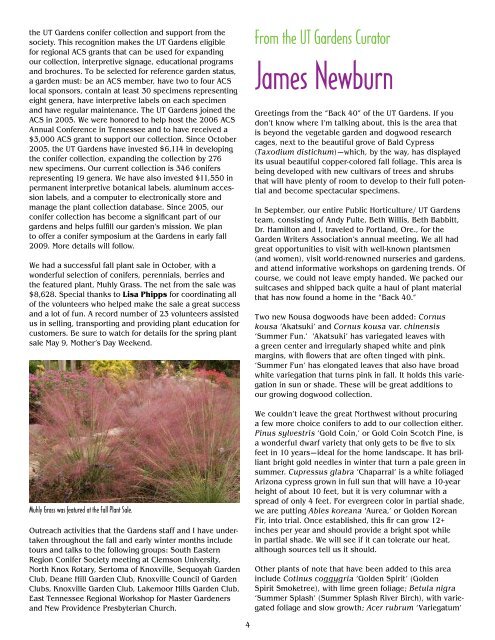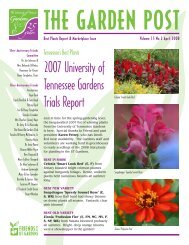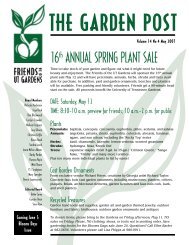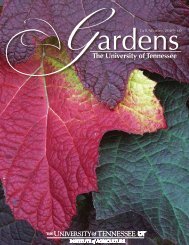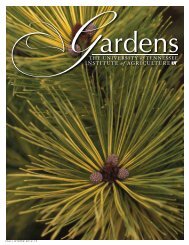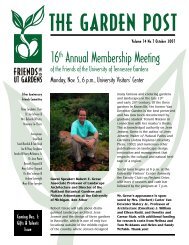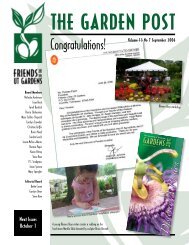New Rose Garden Planned - UT Gardens - The University of ...
New Rose Garden Planned - UT Gardens - The University of ...
New Rose Garden Planned - UT Gardens - The University of ...
Create successful ePaper yourself
Turn your PDF publications into a flip-book with our unique Google optimized e-Paper software.
the <strong>UT</strong> <strong>Garden</strong>s conifer collection and support from thesociety. This recognition makes the <strong>UT</strong> <strong>Garden</strong>s eligiblefor regional ACS grants that can be used for expandingour collection, interpretive signage, educational programsand brochures. To be selected for reference garden status,a garden must: be an ACS member, have two to four ACSlocal sponsors, contain at least 30 specimens representingeight genera, have interpretive labels on each specimenand have regular maintenance. <strong>The</strong> <strong>UT</strong> <strong>Garden</strong>s joined theACS in 2005. We were honored to help host the 2006 ACSAnnual Conference in Tennessee and to have received a$3,000 ACS grant to support our collection. Since October2005, the <strong>UT</strong> <strong>Garden</strong>s have invested $6,114 in developingthe conifer collection, expanding the collection by 276new specimens. Our current collection is 346 conifersrepresenting 19 genera. We have also invested $11,550 inpermanent interpretive botanical labels, aluminum accessionlabels, and a computer to electronically store andmanage the plant collection database. Since 2005, ourconifer collection has become a significant part <strong>of</strong> ourgardens and helps fulfill our garden’s mission. We planto <strong>of</strong>fer a conifer symposium at the <strong>Garden</strong>s in early fall2009. More details will follow.We had a successful fall plant sale in October, with awonderful selection <strong>of</strong> conifers, perennials, berries andthe featured plant, Muhly Grass. <strong>The</strong> net from the sale was$8,628. Special thanks to Lisa Phipps for coordinating all<strong>of</strong> the volunteers who helped make the sale a great successand a lot <strong>of</strong> fun. A record number <strong>of</strong> 23 volunteers assistedus in selling, transporting and providing plant education forcustomers. Be sure to watch for details for the spring plantsale May 9, Mother’s Day Weekend.Muhly Grass was featured at the Fall Plant Sale.Outreach activities that the <strong>Garden</strong>s staff and I have undertakenthroughout the fall and early winter months includetours and talks to the following groups: South EasternRegion Conifer Society meeting at Clemson <strong>University</strong>,North Knox Rotary, Sertoma <strong>of</strong> Knoxville, Sequoyah <strong>Garden</strong>Club, Deane Hill <strong>Garden</strong> Club, Knoxville Council <strong>of</strong> <strong>Garden</strong>Clubs, Knoxville <strong>Garden</strong> Club, Lakemoor Hills <strong>Garden</strong> Club,East Tennessee Regional Workshop for Master <strong>Garden</strong>ersand <strong>New</strong> Providence Presbyterian Church.From the <strong>UT</strong> <strong>Garden</strong>s CuratorJames <strong>New</strong>burnGreetings from the “Back 40” <strong>of</strong> the <strong>UT</strong> <strong>Garden</strong>s. If youdon’t know where I’m talking about, this is the area thatis beyond the vegetable garden and dogwood researchcages, next to the beautiful grove <strong>of</strong> Bald Cypress(Taxodium distichum)—which, by the way, has displayedits usual beautiful copper-colored fall foliage. This area isbeing developed with new cultivars <strong>of</strong> trees and shrubsthat will have plenty <strong>of</strong> room to develop to their full potentialand become spectacular specimens.In September, our entire Public Horticulture/ <strong>UT</strong> <strong>Garden</strong>steam, consisting <strong>of</strong> Andy Pulte, Beth Willis, Beth Babbitt,Dr. Hamilton and I, traveled to Portland, Ore., for the<strong>Garden</strong> Writers Association’s annual meeting. We all hadgreat opportunities to visit with well-known plantsmen(and women), visit world-renowned nurseries and gardens,and attend informative workshops on gardening trends. Ofcourse, we could not leave empty handed. We packed oursuitcases and shipped back quite a haul <strong>of</strong> plant materialthat has now found a home in the “Back 40.”Two new Kousa dogwoods have been added: Cornuskousa ‘Akatsuki’ and Cornus kousa var. chinensis‘Summer Fun.’ ‘Akatsuki’ has variegated leaves witha green center and irregularly shaped white and pinkmargins, with flowers that are <strong>of</strong>ten tinged with pink.‘Summer Fun’ has elongated leaves that also have broadwhite variegation that turns pink in fall. It holds this variegationin sun or shade. <strong>The</strong>se will be great additions toour growing dogwood collection.We couldn’t leave the great Northwest without procuringa few more choice conifers to add to our collection either.Pinus sylvestris ‘Gold Coin,’ or Gold Coin Scotch Pine, isa wonderful dwarf variety that only gets to be five to sixfeet in 10 years—ideal for the home landscape. It has brilliantbright gold needles in winter that turn a pale green insummer. Cupressus glabra ‘Chaparral’ is a white foliagedArizona cypress grown in full sun that will have a 10-yearheight <strong>of</strong> about 10 feet, but it is very columnar with aspread <strong>of</strong> only 4 feet. For evergreen color in partial shade,we are putting Abies koreana ‘Aurea,’ or Golden KoreanFir, into trial. Once established, this fir can grow 12+inches per year and should provide a bright spot whilein partial shade. We will see if it can tolerate our heat,although sources tell us it should.Other plants <strong>of</strong> note that have been added to this areainclude Cotinus coggygria ‘Golden Spirit’ (GoldenSpirit Smoketree), with lime green foliage; Betula nigra‘Summer Splash’ (Summer Splash River Birch), with variegatedfoliage and slow growth; Acer rubrum ‘Variegatum’(Variegated Red Maple); and Platycladus orientalis‘Frankie Boy’ (Frankie Boy Oriental Arborvitae), with agreen fountain-like appearance.I encourage you to visit the “Back 40,” which we reallyshould rename now. “Back” implies that these plantsdon’t deserve to be in a position <strong>of</strong> prominence, and “40”implies that the area is huge. Neither is correct, as thedevelopment and growth <strong>of</strong> this area over the comingyears are sure to entice and inspire the visitor with thewide range <strong>of</strong> plant material that is showcased. Perhaps amore appropriate name for the area would be “DistinctiveTreasures.”Site Fixture UpdateFor those who may not have noticed during the SilverAnniversary Plaza dedication events, all the plannedsite fixtures and amenities have been added by the <strong>UT</strong><strong>Garden</strong>s staff. <strong>The</strong>se include bike racks located next tothe parking lot near the crosswalk to the <strong>Garden</strong>s; a donationbox at the entrance; the donor sign for the FriendshipPlaza construction on the brick fence pillar; and the wastereceptacles throughout the <strong>Garden</strong>s. <strong>The</strong>se are in additionto tables, chairs and garden benches that were already inplace earlier in the summer. All new site fixtures are in thesame matching style, which provides an aesthetic continuitythroughout the <strong>Garden</strong>s.Student Intern <strong>New</strong>sAs part <strong>of</strong> their ongoing education with the <strong>UT</strong> <strong>Garden</strong>s,student interns Chris Brown, Robin Yeary, CoreySchweinke, Amanda Plante and Patrick Miller receivedtheir pesticide application certification in August. Thisinvolves studying for and taking a test on proper integratedpest management techniques, disease and pestidentification, and pesticide application proceduresand safety. <strong>The</strong> certification process is managed by theTennessee Department <strong>of</strong> Agriculture. Continued certificationrequires participation in educational seminarsthroughout the year. This certification and educationhelps ensure responsible environmental stewardship.Congratulations to all on their achievement, and thanksto Beth Willis for organizing and administering the studysessions for the student staff in preparation for the exam.In October, student intern Robin Yeary attended theSoutheastern Regional Conifer Society meeting inClemson, S.C. He attended seminars on designing withconifers, pests <strong>of</strong> conifers and using native understockfor conifer propagation. He also attended hands-on workshopson grafting and pruning conifers. “It was very informative,but the best part was visiting and networking withother people who are as enthusiastic about conifers as Iam,” Robin says.Attendance UpdateSince the visitor counter has been reinstalled in late July,we have been able to document a more accurate count<strong>of</strong> <strong>UT</strong> <strong>Garden</strong>s visitors. While we still are making adjustmentsto the system and our data collection, preliminaryresults are as follows:August 2008………4106 visitorsSeptember 2008…...4861 visitorsOctober 2008……...4544 visitorsMany thanks to Chris Edkins <strong>of</strong> the <strong>UT</strong> Vet School for histechnical expertise and downloading the numbers.Photo by Jack <strong>Rose</strong>4 5


